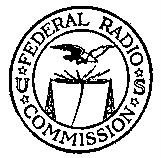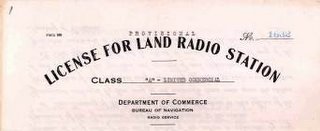In the middle of all this time period the (DOC) The Department of Commerce made some regulations that went into effect on December 1, 1921. It was one of the earliest broadcast rules. It required all non-government broadcasting stations to obtain a limited commercial license. These new licenses came with new three letter call signs. So 6XAJ became KZM.
 This new license also required all stations to broadcast on the single authorized frequency of 833 kHz. Most government and weather broadcasts were allocated on 619 kHz. Now the immediate problem with this dumbass idea is that radio stations can't operate simultaneously on this channel without causing interference. Try to imagine radio as the newest hottest fad at the time. Over 100,000 radios had already been sold. And now, they barely worked because of all the damn crosss-talk. So the owners of the stations met and had to agreed on a time-share schedule. in San francisco the above mentioned KZM not only shared time with KLX but also their transmitter!
This new license also required all stations to broadcast on the single authorized frequency of 833 kHz. Most government and weather broadcasts were allocated on 619 kHz. Now the immediate problem with this dumbass idea is that radio stations can't operate simultaneously on this channel without causing interference. Try to imagine radio as the newest hottest fad at the time. Over 100,000 radios had already been sold. And now, they barely worked because of all the damn crosss-talk. So the owners of the stations met and had to agreed on a time-share schedule. in San francisco the above mentioned KZM not only shared time with KLX but also their transmitter!It got a little better in January of 1922. The Secretary of commerce sponsored the first National Radio Conference. It was decided that high- power stations (above 500 watts) were assigned to 750 kHz, and low-power stations (below 500 watts) remained on 833 kHz. Each station got exclusive use of the frequency for several hours each day. It was an improvement but the rudimentary radios of the time could babrely discren between the two frequencies. Despite this, about 1.5 million radios had been sold by the end of that year.
 This cluttering was absolutely crippling in some cities. In Washington D.C. there were at least 11 stations sharing that frequency. This includes WQAW, WJH, WDW, WHAQ, WPM, WIL, WEAS, WIAY, WDM, and WMU. When the regulation was first issued in 1921, there were only 28 radio stations on the air. But in the year 1922 the DOC issued 480 more licenses! This was becoming a problem. By 1925 there were more than seven hundred stations and Herbert Hoover, then Secretary of the Department of Commerce, had to block the further issue of licences.
This cluttering was absolutely crippling in some cities. In Washington D.C. there were at least 11 stations sharing that frequency. This includes WQAW, WJH, WDW, WHAQ, WPM, WIL, WEAS, WIAY, WDM, and WMU. When the regulation was first issued in 1921, there were only 28 radio stations on the air. But in the year 1922 the DOC issued 480 more licenses! This was becoming a problem. By 1925 there were more than seven hundred stations and Herbert Hoover, then Secretary of the Department of Commerce, had to block the further issue of licences.By 1924, the AM band stretched from 550kHz to 1500 Khz. Three levels of power, 5000, 500 and 100 watts were established. These became the designations of "clear", "regional" and "local". Finally, the Radio Act of 1927 enabled the government (thru the FRC) the power to regulate the technical side of stations. Thus we traded set of headaches was traded for another.
early FRC map: http://www.eliillinois.org/00001_00/main/map1932/map1932.jpg




No comments:
Post a Comment